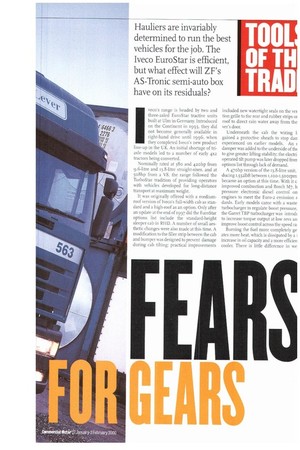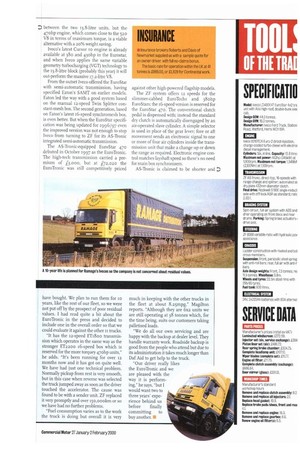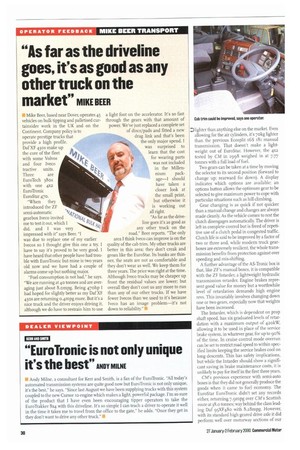Hauliers are invariably determined to run the best vehicles for
Page 29

Page 31

Page 32

Page 33

If you've noticed an error in this article please click here to report it so we can fix it.
the job. The Iveco EuroStar is efficient, but what effect will ZF's AS-Tronic semi-auto box have on its residuals?
veco's range is headed by two and three-axled EuroS tar tractive units built at Ulm in Germany. Introduced on the Continent in 1993, they did not become generally available in right-hand drive until 1996, when they completed Iveco's new product line-up in the UK. An initial shortage of triaxle models led to a number of early 4)(2 ractors being converted.
Nominally rated at 380 and 42olip from 9.6-litre and 13.8-litre straight-sixes. and at 5o8hp from a V8, the range followed the TurboStar tradition of providing operators with vehicles developed for long-distance transport at maximum weight.
It was originally offered with a mediumroof version of Iveco's full-width cab as standard and a high-roof as an option. Only after an update at the end of i997 did the EuroStar options list include the standard-height sleeper cab in RII.D. A number of small aesthetic changes were also made at this time. A modification to the filler strip between the cab and bumper was designed to prevent damage during cab tilting; practical improvements included new watertight seals on the vex tion grille to the rear and rubber strips (3/ roof to direct rain water away from the ver's door.
Underneath the cab the wiring 1, gained a protective sheath to stop dan experienced on earlier models. An t damper was added to the underside of tht to give greater lifting stability; the electri operated tilt pump was later dropped fron options list through lack of demand.
A 47ohp version of the 13.8-litre unit, clueing 1,532Ibft between 1,100-1,500rpm became an option at this time. With it c, improved combustion and Bosch M7, h pressure electronic diesel control on engines to meet the Euro-2 emission s dards. Early models came with a waste turbocharger to regulate boost pressure, the Garret TBP turbocharger was introch to increase torque output at low revs an improve boost control across the speed ra Burning the fuel more completely ge ates more heat, which is dissipated by a increase in oil capacity and a more efficien cooler. There is little difference in we
D between the two 13.8-litre units, but the 47ohp engine, which comes close to the 520 V8 in terms of maximum torque. is a viable alternative with a 20% weight saving.
Iveco's latest Cursor TO engine is already available at 380 and 43ohp in the Eurostar, and when Iveco applies the same variable geometry turbocharging (VGT) technology to the 13.8-litre block (probably this year) it will out-perform the massive17.2-litre V8.
From the outset Iveco offered the EuroStar with semi-automatic transmission, having specified Eaton's SAMT on earlier models. Eaton led the way with a good system based on the manual 12-speed Twin Splitter constant-mesh box. The second generation, based on Eaton's latest r6-speed synchromesh box, is even better. But when the EuroStar specification was being updated for 1996/97 even the improved version was not enough to stop Iveco from turning to ZF for its AS-Tronic integrated semi-automatic transmission.
The AS-Tronic-equipped EuroStar 470 debuted in October 1997 as the EuroTronic. The high-tech transmission carried a premium of L3,000, but at L72,o2o the EuroTronic was still competitively priced against other high-powered flagship models.
The ZF system offers 12 speeds for the slimmer-cabbed EuroTechs and 38ohp EuroStars; the r6-speed version is reserved for the EuroStar 470. The conventional clutch pedal is dispensed with; instead the standard dry clutch is automatically disengaged by an air-operated slave cylinder. A simple selector is used in place of the gear lever; fore or aft movement sends an electronic signal to one or more of four air cylinders inside the transmission unit that make a change up or down the range as required. Electronic engine control matches layshaft speed so there's no need for main box synchronisers.
AS-Tronic is claimed to be shorter and 0 )lighter than anything else on the market. Even allowing for the air cylinders, it's 70kg lighter than the previous Ecosplit r6S 18t manual transmission. That doesn't make a lightweight out of EuroStar. However, the 4x2 tested by CM in 1998 weighed in at 7.77 tonnes with a full load of Fuel.
Two gears can be taken at a time by moving the selector to its second position (forward to change up; rearward for down). A display indicates which options are available; an options button allows the optimum gear to be selected to give maximum power to cope with particular situations such as hill climbing.
Gear changing is as quick if not quicker than a manual change and changes are always made deanly. As the vehicle comes to rest the dutch disengages automatically. The driver is left in complete control but is freed of repetitive use of a clutch pedal in congested traffic. Clutch life is said to be improved by a factor of two or three and, while modem truck gearboxes are extremely resilient, the whole transmission benefits from protection against over speeding and mis-shifting.
A further advantage of the AS-Tronic box is that, like Z F's manual boxes, it is compatible with the ZF Intarder, a lightweight hydraulic transmission retarder. Engine brakes represent good value for money but a worthwhile level of retardation demands high engine revs. This invariably involves changing down one or two gears, especially now that weights have been increased.
The Intarder, which is dependent on prop shaft speed, has six graduated levels of retardation with a maximum output of 42okW, allowing it to be used in place of the service brake system, in whatever gear, for up to 90% of the time. In cruise control mode overrun can be set to restrict road speed to within specified limits keeping the service brakes cool on long descents. This has safety implications, but while the Intarder should show a significant saving in brake maintenance costs, it is unlikely to pay for itself in the first three years.
CM's previous experience with semi-auto boxes is that they did not generally produce the goods when it came to fuel economy. The EuroStar EuroTronic didn't set any records either, returning 7.mpg over CM's Scottish route at 38.0 tonnes; way behind the class leading Daf 95XF480 with 8.28mpg. However, with its standard high geared drive axle it did perform well over motorway sections of our
test route where the engine purred along at a sedate 1,370rpm while ample power and fast gear changes also combined to give a good result over the tough hilly A68 section.
There are now some 5,300 EuroTronics in service throughout Europe, but few models
are introduced without some teething problems, and despite years of development ZF's AS-Tronic gearbox has not been immune. On early EuroTronic gearboxes there have been problems with premature failure of the layshaft clutch brake, resulting in poor shift quality. Iveco says the problem was resolved for vehicles in service by introducing an uprated clutch brake via a controlled rework programme. Also, the ZF control unit's magnetic valves proved unreliable on a few 1997 models. All suspect units were replaced under warranty on the 12 UK vehicles affected.
A sub standard part on some units, built in mid-1999, was found to cause some gearboxes to overheat, preventing the truck from being driven until the gearbox cools down. ZF has introduced a correction programme which is carried out at the PDI stage.
• by III Irak












































































































